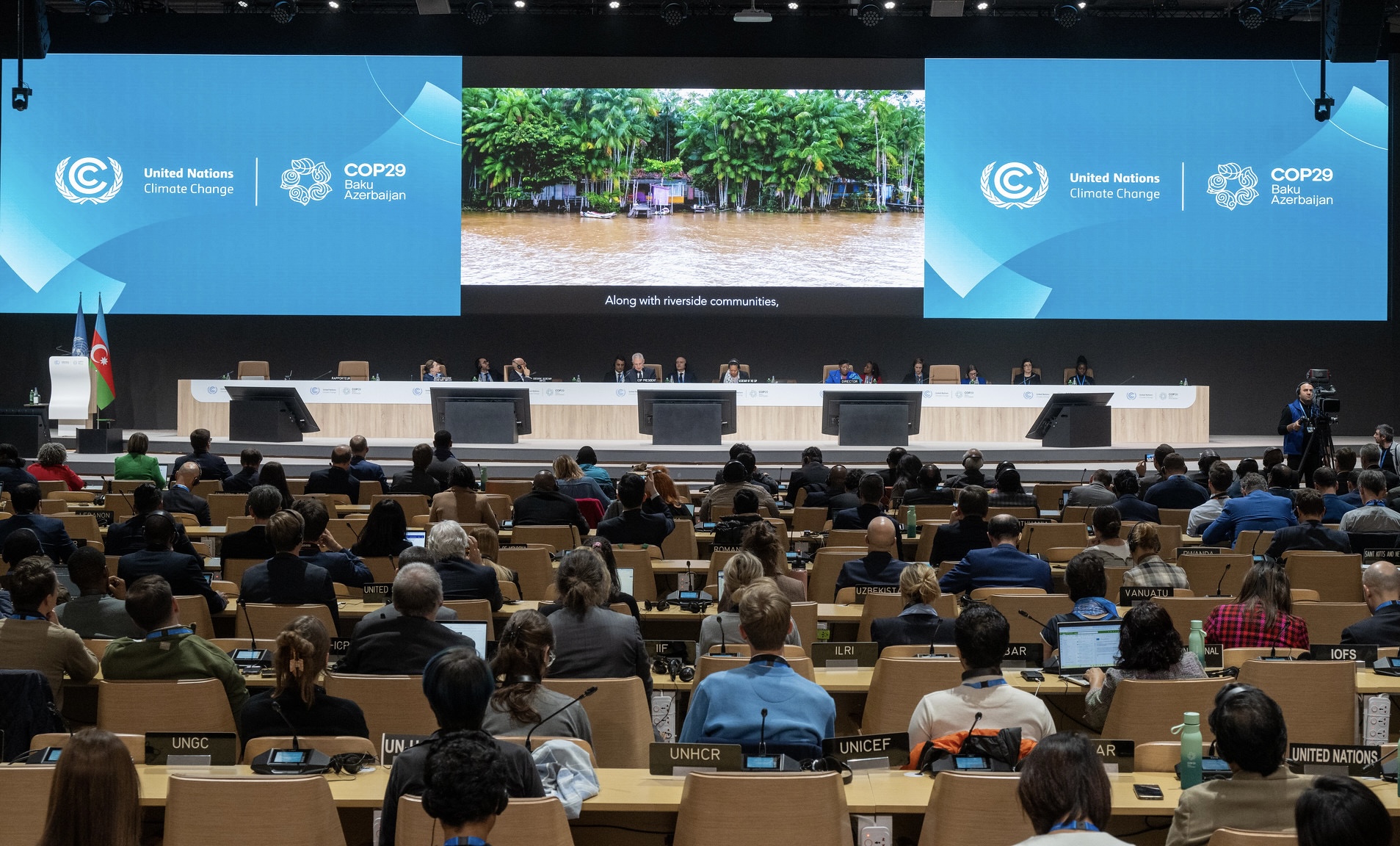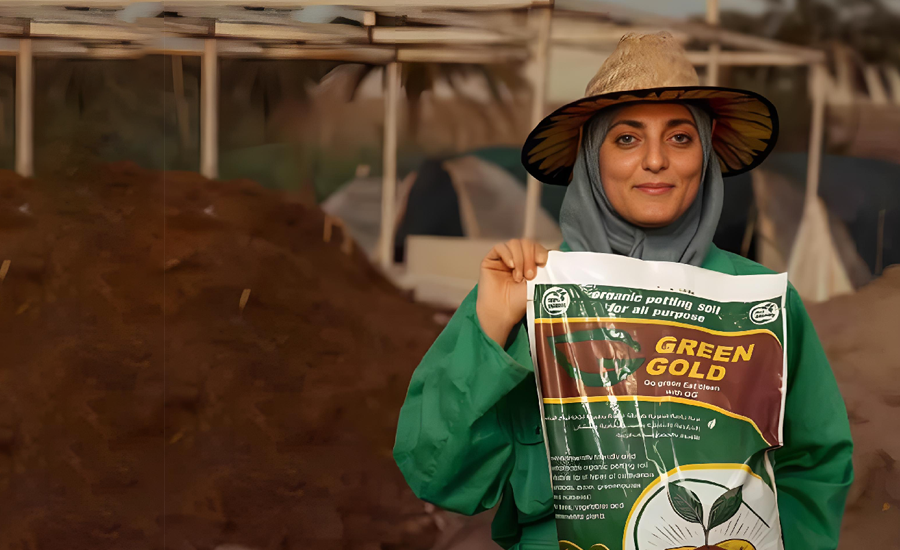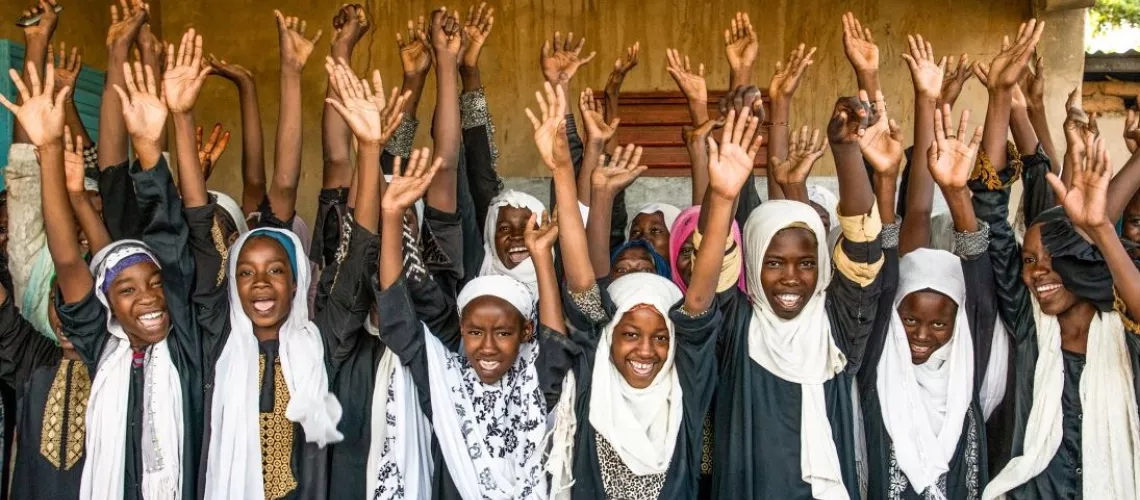Every night After nine O’clock in the evening, in a mobile cart, “Medhat” – a pseudonym – begins his work as a fish seller specializing in selling “shebeen” fish on Al-Amin Street in Port Said Governorate, which overlooks the Mediterranean Sea in Egypt.
“Shebeen” is the popular name given by the people of the city to different types of “ray” or “shebeen” fish. Medhat sells this type of fish only. After he buys it from fishermen, he removes the skin from the fish’s body, then cuts it up and sells it in kilograms. Usually, the buyer puts it in a bowl of vinegar and lemon for a night to get rid of its strong smell. Sometimes Medhat can’t find it, as it is most abundant in the winter, and it is a little difficult to catch during the rest of the year.
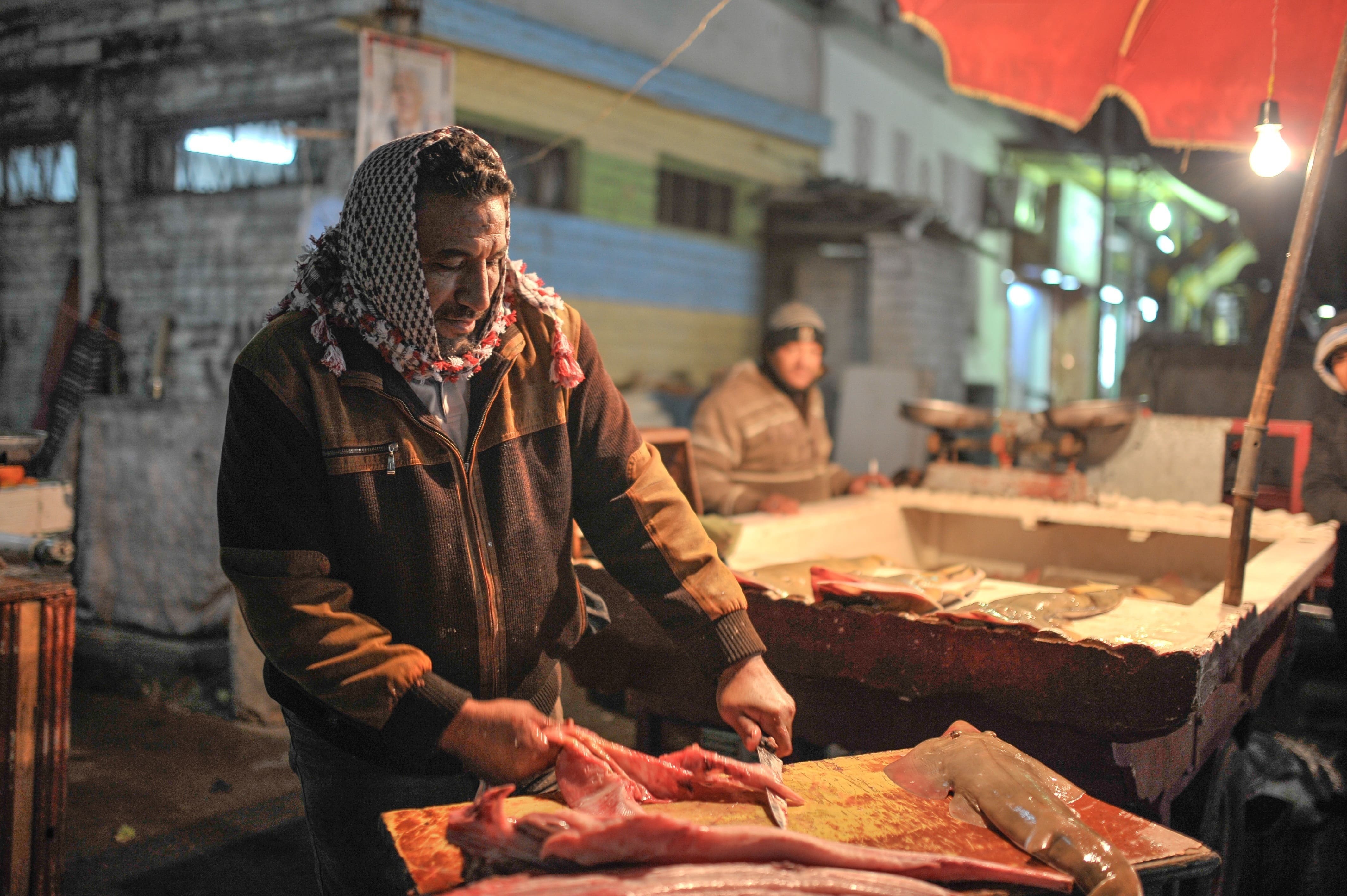
In another tour at the new fish market in Port Said in the suburbs district, ray fish were sold by a few sellers in the form of “slices” after cleaning them, at a price of 150 pounds per kilo, or about five dollars. Ahmed Al-Laili, a fish seller in the market, said: “There are specialized sellers who can clean them because they contain a lot of cartilage or bones.” He also told us that he stores them in the winter because they are more available . He keeps them frozen so that he can sell them throughout the year.
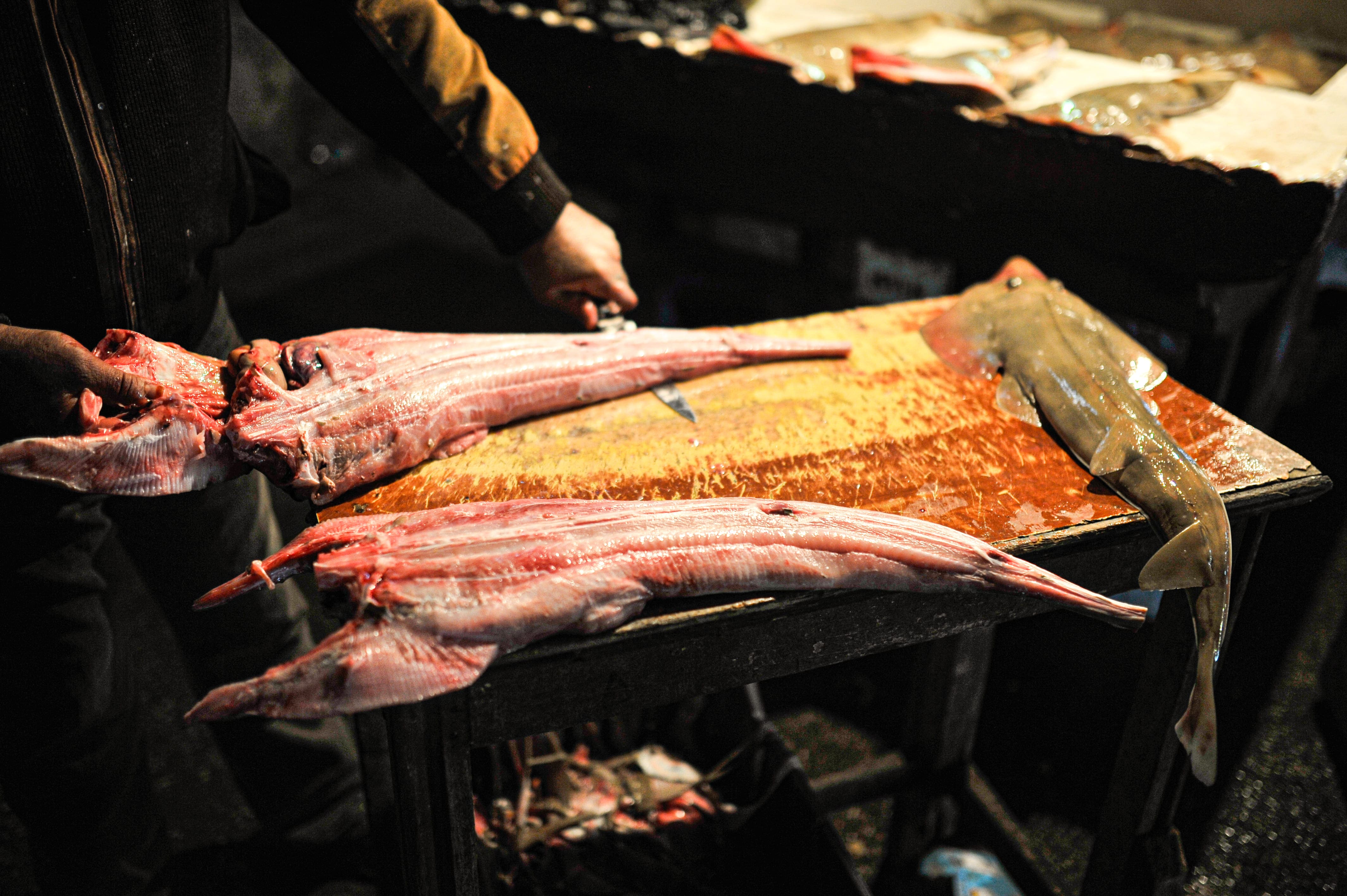
In 2021, a study Published by the journal Nature, found that during the last fifty years, the numbers of sharks and rays decreased by 71% after fishing pressure increased 18- times since 1970, and this led to endangering three-quarters of these fish species to extinction, while another study , published in January 2023, in the Nature Communications journal, found that nearly two-thirds of sharks and rays, about 134 species, are associated with coral reefs and in danger of extinction This is primarily due to overfishing, while other factors such as climate change and habitat degradation also play an important role.
It is believed that it is beneficial for the backbones
Many Egyptians believe that ray fish in particular are rich in vitamins, and are useful for treating the spine and strengthening the bones. They give their different types many popular names, such as “cowfish,” “muharat,” “shebeen,” sea devil, or “laughing fish.” “The nail of the spine,” which is what we spotted during our tours of the fish markets in three Egyptian governorates overlooking the Mediterranean Sea, namely “Port Said, Damietta, and Alexandria.” But the most famous name was “Al-Shebin,” which we searched for via the “Google” search engine, and we found dozens of video clips showing how to cut a fish and cook it , It is promoted as being rich in proteins and good for bones.
It belongs to the cartilaginous fish family
Rays belong to the family of cartilaginous fish. They have lower gills and a flattened body. They are always associated with sharks. Some types of them are widespread in the Mediterranean Sea in Egypt, in addition to other types in the Red Sea. Most of them are “ovoviviparous,” meaning they spawn and give birth at the same time. While there are a few that represent an exception and lay eggs in suspended cocoons, they may also live in shallow waters or small depths, or in depths extending to more than 700 meters, according to Dr. Mahmoud Mahrous Farrag, Assistant Professor of Marine and Fish Sciences at the Faculty of Science at Al-Azhar University.
Mahrous added that in Egypt, more than 20 species of ray fish have been recorded in the Mediterranean, but not all species are exploited and targeted. Rather, the focus is on catching four or five species that have economic value in fish markets, and some of them have large sizes, the most prominent of which are: The “manta ray” fish, which is known as the sea devil, and its size may range from one kilogram to 500 kilograms, the “batfish” , and the “monkey” fish. There is also a famous species called the “spotted cow”, which has great fishing pressure and is in demand in fish markets, but it has almost disappeared, adding that usually these fish are divided into pieces first, then sold by the kilo.
Guitarfish is the second most sought-after species in the market
He said that there is also a targeted species, which is the “muharrat fish” or known as “guitar fish”, and it is considered the second type of ray fish required in the market.
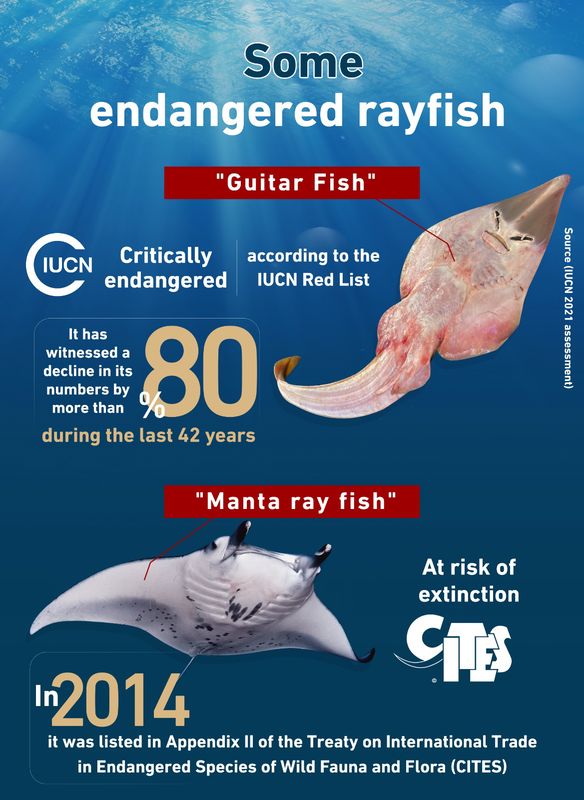
These fish tend to be slow-growing, late-maturing, and produce few young after long gestation periods. This means that overfishing can destroy fish stocks, which then fail to replenish, according to a report by the World Conservation Fund.
According to the IUCN Red List, in an assessment issued in 2021,the common guitarfish is classified as ‘Critically Endangered’ and has seen its population decline by more than 80% over the last three generations (42 years), based on abundance data and actual levels of exploitation while the manta ray is classified as ‘Vulnerable to Extinction’ “.
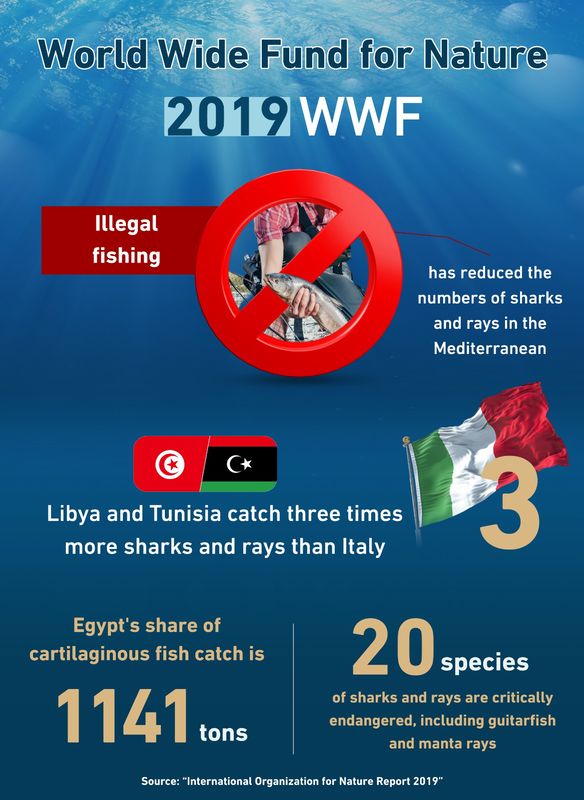
In 2014, manta ray species were listed in Appendix II of the treaty International Trade in Endangered Species of Wild Fauna and Flora (CITES), this treaty classifies Species listed in Appendix II as not necessarily threatened with extinction, but whose trade is controlled to avoid use that is incompatible with their survival.
In Damietta Governorate, “guitar fish” are sold by the kilo
As for Damietta Governorate, we toured the “Qantara Fish” market, and in one of the ancient shops, we found one of the large rays, “guitar fish”, We spoke with the owner of the shop, and he said that its name is ”shebeen” “spinefish” or the laughing fish”, and that it has a high percentage of vitamins that are beneficial for joints and bones, and there are consumers who request and search for it specifically, and it is targeted by fishermen.
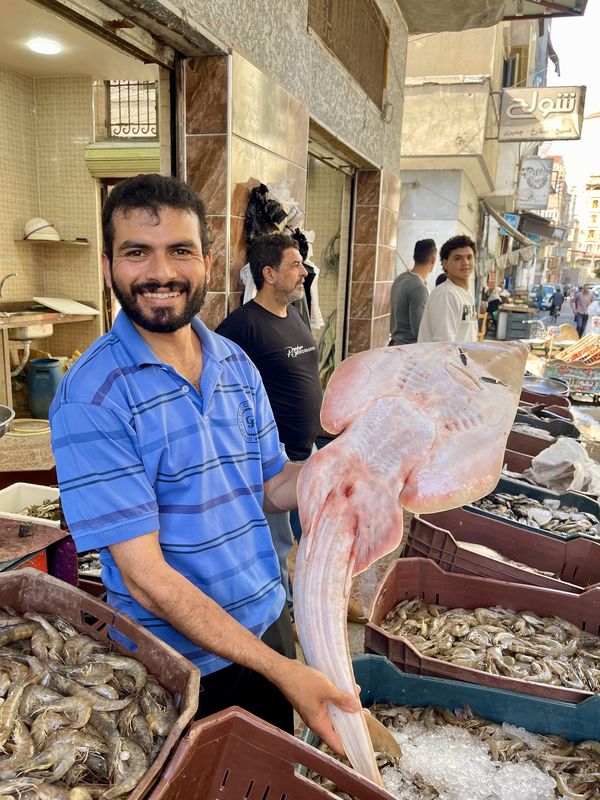
Muhammad Tawfiq says: “The size of the fish ranges from small to very large. Sometimes I sell the fish in its original state, and sometimes it is sold in pieces. The average price per kilo is 80 pounds, and it is most abundant in the fall.”
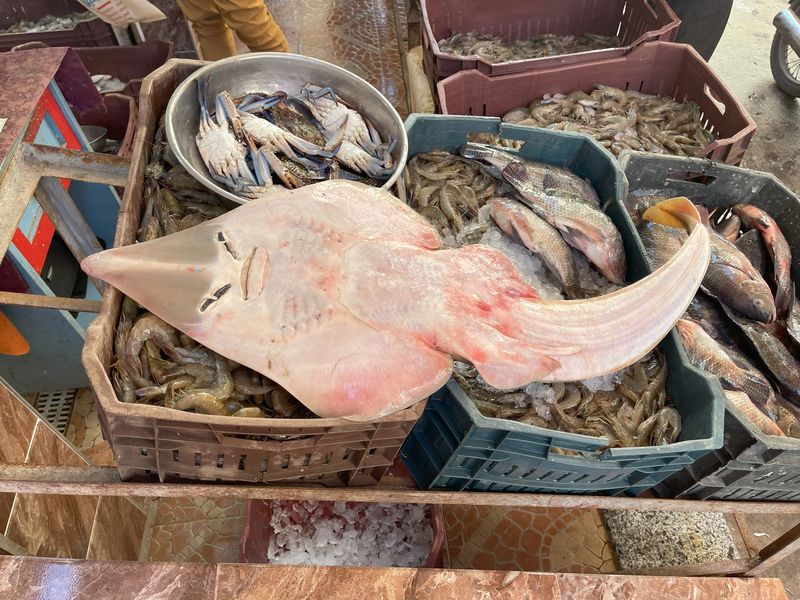
In Alexandria…the name “Al-Muharat” is widespread.
On another tour we took in Alexandria Governorate, we met “Ahmed – a pseudonym”, a fish seller who has been working in his profession for 28 years. He says that the popular name for it in his governorate is “Al-Muharat”, or “cow” fish, which is given to ray fish. The largest in size, and he told us that consumers buy it because it has a delicious taste, and they believe that it is useful for building children’s bones. The merchant sells it without cutting it, but the sellers skin it, then cut it and sell it, and remove the chain of vertebrae in the back. He also said that it spreads between the months of March and May, and they are sold in pieces, and the price of a kilogram ranges between fifty pounds and 120 pounds.
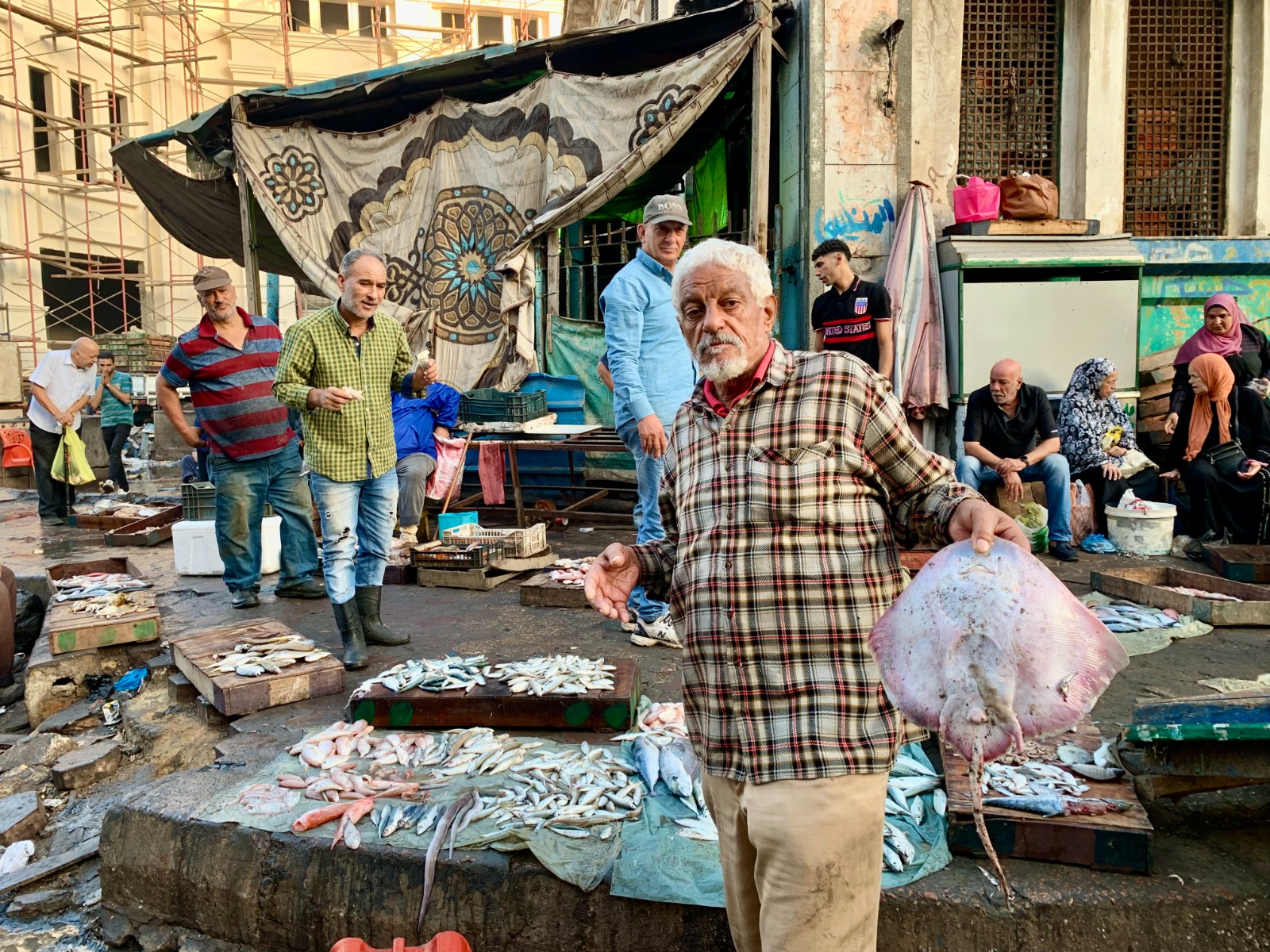
We met another fisherman – who refused to give his name – who was selling small rays among many other fish. He called them “muharat” and said that he sells them on a daily basis, and their weight ranges from one to five kilograms, and the price of a kilo ranges between 60 and 80 pounds.
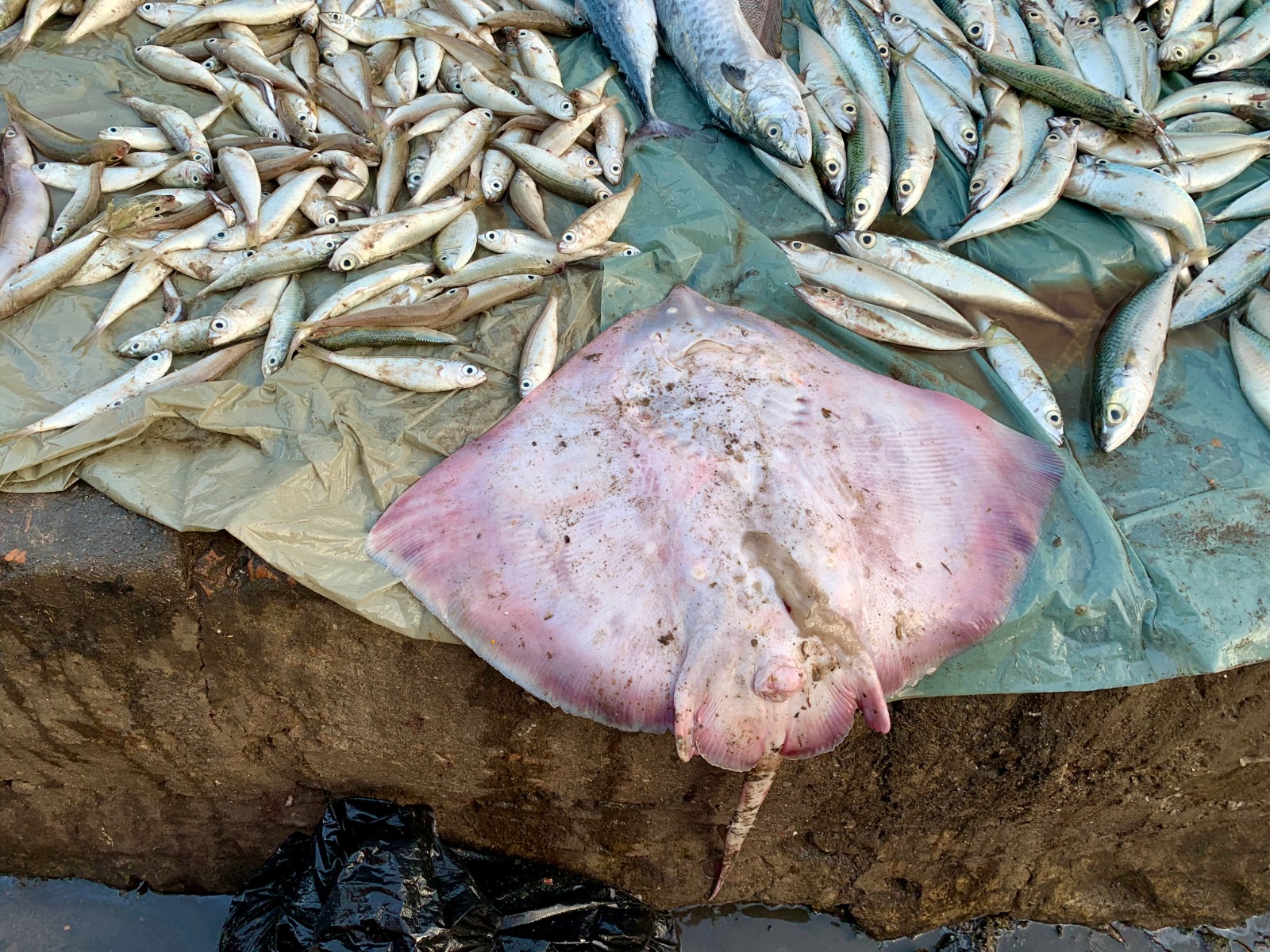
According to the Food and Agriculture Organization of the United Nations (FAO), in its latest report in 2022, on the “State of Fisheries in the Mediterranean and Black Sea,” it states that Egypt accounts for 8.9% of the fishing capacity in the Mediterranean region, and ranks fifth after Turkey, Italy, Tunisia and Algeria, the five countries together represent about 64% of the value of fishing in the region. Despite the lack of data, the report suggested that sharks and rays are among the most endangered species in Mediterranean fisheries due to fishing pressure. In parallel, it was observed that the overall fish production in the Mediterranean and Black Sea has decreased by about 15% since 2020.
Egypt is also a signatory and essential member of the Fisheries Commission of the Mediterranean (GFCM) since 1951 – a regional fishery management organization whose goal is to ensure the conservation and sustainable use of living marine resources.
In an attempt to preserve the various species of rays from decreasing in number, and reduce the risk of their extinction due to fishing activities, the FAO issued in 2018, in partnership with (GFCM), a guideline that includes guidelines in the event of incidental longline fishing of sharks or rays in the Mediterranean. The guideline states: Removing the Hook from a Ray, Rays rarely survive release due to jaw damage, and although these fish can be dangerous, there are simple handling procedures that increase their chances of survival.
In the case of catching these fish, the guide requires cutting the hook or the line attached to it if the fishing hook is attached near the mouth, but if the hook is deeply entangled in the body of the fish, it must be extracted in a specific way to allow the fish to fall back into the water.
At the same time, the Authority issued recommendations regarding the fishing of sharks and rays, in which it stressed the prohibition of trading these fish after skinning and cutting them in first-class markets. It also said that fisheries protection measures require reducing trawling in coastal areas, requiring environmental protection centers to ensure that trawling activities are prohibited within three nautical miles off the coast, and to develop a specific monitoring plan for trawl fisheries that will grant them conditional exceptions.
The authority said that high protection must be provided to the endangered species of sharks and rays listed in the Barcelona Convention for the Protection of the Marine Environment, and it prohibited keeping, transporting, storing or selling fish listed in Appendix II of the convention.
In 2019, a report by the International Organization for Conservation of Nature said that the unsustainable and illegal fishing led to the depletion in the number of sharks and rays in the Mediterranean region, and it was found that Libya and Tunisia catch sharks and rays three times more than Italy, whose share reached 1,347 tons, followed by Egypt, which had a share of catching sharks and rays, according to the report, of “1141 tons.”
The report said that some species are directly targeted, while many of the remaining species are caught as unwanted bycatch, and more than 60 species were recorded in the trawl nets in the region, while in some areas sharks and rays represent more than a third of the total longline catch, adding: “There are 20 species of sharks and rays that are critically endangered, including the guitarfish and manta rays.”
In 2016, Egypt was among 41 countries that signed the Convention on Migratory Species Memorandum of Understanding for the Conservation of Migratory Sharks and Rays, and the signatories adopted a conservation plan aimed at increasing the understanding of migratory shark and ray populations through improving research; improving the sustainability of directed and undirected fisheries; And protecting vital habitats. Egypt is also a member of the International Commission for the Conservation of Tunas in the Atlantic Ocean, which has a department specialized in preserving sharks and related species in tuna fisheries. It is assumed that the signatory countries will activate a plan to protect these fish, and reveal their fishing types and used methods.
This part was confirmed by Dr. Mahmoud Mahrous, who said: ” There are other types of rays that are caught incidentally and are not targeted, and are sold at a cheap price. That is, the weight and shape play a role in attracting the economic interest of fishermen because they exploit them as meat. Net fishing results in the catching of different types of rays, which are then classified and sold as first class or a second, or it is discarded if it is of no value to the fisherman.”
Migration season is between April and August
He said that there are incubator areas for ray fish of various types in the Mediterranean Sea in Egypt, as they are spread in the Delta region and west of Alexandria, while the ray manta fish is spread along the Mediterranean coast because it is classified as a migratory fish, meaning it moves in flocks during its season, and during the fishing season, some of them can be caught from the water near the shore, commenting: “The migration season for these fish is concentrated between the months of April and August, and although these fish are present throughout the year, there are hunting seasons and breeding seasons, so we must scientifically take these timings into account, because, for example, in the breeding seasons, plans must include procedures to preserve and reproduce these species, And protecting biodiversity, while fishing activities can be regulated during fishing seasons in which some species leave their area to areas that are easily accessible to fishermen.”
Fish conservation laws
Mahrous said that although the focus in general was on sharks, there are Egyptian laws applied by the “Lakes and Fisheries Protection and Development Authority,” which is the government body concerned with preserving fish resources in Egypt, and these laws generally seek to prevent unjust and illegal fishing, and preserving fish wealth.
He added: “The agency set conditions for the use of nets during fishing operations, to preserve fish stocks, and set specifications for the sizes of fish allowed to be caught, and prohibited fishing at certain times to maintain the fish reproduction process. In the past, the Egyptian Ministry of Agriculture temporarily banned the trade and fishing of exotic and poisonous fish, and the ray fish were among them, because there was a fear that they represent a danger to humans because their tails had thorns that could cause wounds and infections, but later their tails were cut off and sold.”
Sub-laws aimed at fish conservation in general
He continued that there is a law established by the Egyptian Ministry of Environment that criminalizes the fishing and trade of sharks that belong to the same cartilaginous family that includes “ray fish” with the aim of preserving biodiversity and marine life, but nevertheless they are caught and sold in markets in violation of the law. As for ray fish, There are always instructions for preserving them.
He added: “In the recent period, the presence of cartilaginous fish, whether sharks, rays, or shellfish, has decreased on the Mediterranean coast in Egypt, so fishermen’s awareness must be increased, and oversight must be increased, because fishing with illegal nets with inconsistent specifications causes the collection of many species, and harvests fish of smaller sizes, which harm fish stocks, and some nets harm the marine environment itself, including algae and weeds, and the natural habitats that protect marine organisms.”
Ahmed Diab, a researcher at the Fish Research Center of the Egyptian Ministry of Agriculture, said that most stingrays are found in the seas, but some of them migrate towards medium-salinity estuaries. They feed on plankton and molluscs, and cannot see their victim, because their mouths are at the bottom of their bodies, and their eyes are at the top, which prompts them to use their sense of smell.
And he said: “Overfishing is one of the most important threats facing marine ecosystems. Climate change also affects the locations of rare fish, and thus they are exposed to the risk of extinction. Sea devils or manta rays are among more than 16 thousand species threatened with extinction, as marine life has lost About 30% of its species are the result of overfishing.”
How does hunting affect biodiversity?
Diab says that rays play an important role in biodiversity by cleaning the marine environment, as they feed on organisms that live at the bottom of the sea or near it, and therefore the increasing pressures resulting from climate change, overfishing, pollution, and habitat destruction threaten the health of the marine environment. Unsustainable fishing practices, such as bottom trawling and the use of destructive fishing gear, can destroy natural habitats and deplete fish populations. This not only disrupts the delicate balance of the marine food web and loses biodiversity, but also jeopardizes the livelihoods of communities in coastal areas that depend on fishing.
by: Hadeer El-Hadary
You can read the Arabic version of the investigation here







